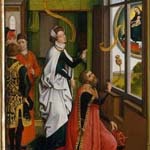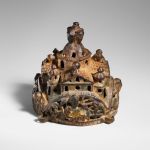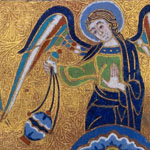 |
 |
 |
Above, from left to right: Detail from a fifteenth-century panel of The Nativity that shows the Emperor Augustus censing an??apparition of the Virgin and Child; cover of a gilded copper censer in The Cloisters Collection (1979.285); Detail from Panel with Censing Angels, on display in the Treasury at The Cloisters.
The ceremonial use of incense in devotions and rites of purification?? is common to many religious traditions?? and dates back to antiquity. (The incense trade was of great economic importance.)?? While some animal substances such as ambergris and musk are used, most incenses are of botanical origin. A number of species and plant parts have been exploited for their aromatic properties, including roots like vetiver and galangal; woods and barks like cedar, cassia, and juniper; leaves like sage and patchouli; seeds and fruits like coriander and nutmeg, and buds and flowers like clove and saffron.?? In the Judeo-Christian tradition, aromatic resins like frankincense, myrrh, and bdellium, or false myrrh, are the most important constituents. All three of these fragrant resins are derived from plants in the botanical family Burseraceae. The incenses used in the Roman Catholic and Eastern Orthodox Churches today include myrrh, frankincense, and other aromatics. The??perfumed smoke that rises from the censer is interpreted as a symbol of the prayers of the faithful rising to heaven.
The term “bdellium” has been applied to the aromatic substance of as many as four species of Commiphora. True myrrh, C. myrrha??or abyssinica, was a component of the Holy Oil of Jewish ritual. According to the Gospel of Matthew, the three Magi presented the infant Jesus with gifts of gold, frankincense, and myrrh. In the Gospel of John, Joseph of Arimathea and Nicodemus brought many pounds of myrrh and aloes to??the tomb of Jesus??to prepare??his??body for burial.
The ancient Egyptians used myrrh to embalm the dead and as a burnt offering in temples. The Greeks and Romans also used it as an incense. According to Ovid’s Metamorphoses, Myrrha, the daughter of the king of Cyprus and the mother of Adonis, was banished from Cyprus and fled to Arabia Felix, where the gods transformed her into a myrrh tree. The god Adonis was born from “her” trunk.
The only incense plant now grown here at The Cloisters??is Commiphora africana, native to northwestern Africa and Arabia. Known as false myrrh, or bdellium, it belongs to the same genus as the true myrrh, Commiphora myrrha. We once had two specimens of C. africana, but have been reduced to one, which is now a shrubby plant about a foot and a half tall and two and a half feet wide. The native habitat of bdellium is dry savanna or rocky soil with a minimum of rainfall. It is grown in a pot and placed out on a sunny parapet in Bonnefont Cloister in the shelter of the arcade to help protect it from summer rain. In fall, the plant defoliates and the thorny branches remain bare until early spring. It is removed to a greenhouse and kept dry until it breaks dormancy in March. As with other incense plants in this family, the resinous gum is exuded when the bark is incised, and the “tears” are then collected. As our??specimen is so precious, we’ve never experimented with this technique, lest we weaken or injure the plant.?? The resin produced in our climate would probably not be of??good quality.
???Deirdre Larkin
Sources:
Anderson, Frank J, ed. “Herbals through 1500,” The Illustrated Bartsch, vol. 90. New York: Abaris, 1984.
Moldenke, Harold N. and Alma L. Moldenke. Plants of the Bible. Waltham, MA: 1952. Reprinted. New York: Dover Publications, 1986.
Tags: bdellium, Commiphora africana, Commiphora myrrha, frankincense, incense, myrrh
